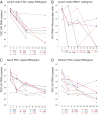Persistent HIV-1 replication is associated with lower antiretroviral drug concentrations in lymphatic tissues
- PMID: 24469825
- PMCID: PMC3926074
- DOI: 10.1073/pnas.1318249111
Persistent HIV-1 replication is associated with lower antiretroviral drug concentrations in lymphatic tissues
Abstract
Antiretroviral therapy can reduce HIV-1 to undetectable levels in peripheral blood, but the effectiveness of treatment in suppressing replication in lymphoid tissue reservoirs has not been determined. Here we show in lymph node samples obtained before and during 6 mo of treatment that the tissue concentrations of five of the most frequently used antiretroviral drugs are much lower than in peripheral blood. These lower concentrations correlated with continued virus replication measured by the slower decay or increases in the follicular dendritic cell network pool of virions and with detection of viral RNA in productively infected cells. The evidence of persistent replication associated with apparently suboptimal drug concentrations argues for development and evaluation of novel therapeutic strategies that will fully suppress viral replication in lymphatic tissues. These strategies could avert the long-term clinical consequences of chronic immune activation driven directly or indirectly by low-level viral replication to thereby improve immune reconstitution.
Keywords: FDC network; drug levels; pharmacokinetics.
Conflict of interest statement
The authors declare no conflict of interest.
Figures





Comment in
-
Anti-HIV drug particles may overcome lymphatic drug insufficiency and associated HIV persistence.Proc Natl Acad Sci U S A. 2014 Jun 24;111(25):E2512-3. doi: 10.1073/pnas.1406554111. Epub 2014 Jun 2. Proc Natl Acad Sci U S A. 2014. PMID: 24889644 Free PMC article. No abstract available.
References
-
- Carcelain G, Autran B. Immune interventions in HIV infection. Immunol Rev. 2013;254(1):355–371. - PubMed
Publication types
MeSH terms
Substances
Grants and funding
LinkOut - more resources
Full Text Sources
Other Literature Sources
Medical

